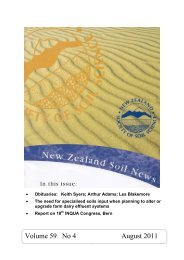Download - New Zealand Society of Soil Science
Download - New Zealand Society of Soil Science
Download - New Zealand Society of Soil Science
You also want an ePaper? Increase the reach of your titles
YUMPU automatically turns print PDFs into web optimized ePapers that Google loves.
David Houlbrooke and Richard Muirhead have been on the road speaking at some recent field days<br />
on the management <strong>of</strong> farm dairy effluent. Field days were held near Gore and Balclutha as part <strong>of</strong><br />
initiatives from Fonterra and Environment Southland (Gore field day) and the Otago Regional Council<br />
(Balclutha). Dairy effluent continues to be a difficult compliance issue for many farms on many<br />
rolling topography’s, mole and pipe drained soils and poorly drained soils, particularly in the southern<br />
regions <strong>of</strong> the South island. Dave Houlbrooke has also been working on informing policy around<br />
‘best management practices’ for dairy effluent for Horizons Regional Council and together with Ross<br />
Monaghan for Environment Southland. Ross Monaghan has also been involved in the testing and<br />
training <strong>of</strong> the soon to be related updated version <strong>of</strong> Overseer nutrient budgets® model<br />
Richard McDowell attended the 11 th international symposium on ‘Interactions between sediment and<br />
water’ held in Esperance, Western Australia. Richard presented a paper entitled ‘Effects <strong>of</strong> wetting<br />
and drying cycles on phosphorus forms in sediments from upland streams in South Otago, <strong>New</strong><br />
<strong>Zealand</strong>’. Of course Rich took some time <strong>of</strong>f after the conference to travel through the Mt Barker and<br />
Margaret river wine growing regions!<br />
Nth Otago LUCI programme field research site during drought conditions<br />
Along with the rest <strong>of</strong> the country, Otago<br />
has been effected by a long period <strong>of</strong> dry<br />
weather which has highlighted country that<br />
has irrigation water compared for country<br />
that does not. In order to capture some<br />
images <strong>of</strong> this production difference, some<br />
Invermay staff (Dave Houlbrooke, M.S<br />
Srinivasan and Sonya Walker) recently<br />
jumped into a small plane and took photos<br />
<strong>of</strong> the LUCI programme field research site<br />
in North Otago (see photo below). For<br />
those unsure, the plots with green pasture<br />
are the irrigated ones and the brown ones<br />
are dryland plots.<br />
Massey University<br />
Loga Loganathan and Jeya Jeyakumar attended the <strong>New</strong> <strong>Zealand</strong> Trace Elements Group<br />
Conference in Hamilton from 13 to 15 February. Loga presented an oral paper on ‘Accumulation,<br />
dynamics and risks <strong>of</strong> fertiliser-derived fluorine in grazed pastures - a review’ (co-authors: Mike<br />
Hedley and Neville Grace (AgResearch)). Jeya presented an oral paper on his PhD research, ‘Copper<br />
and zinc fractionation and speciation in sewage sludge amended with metals’ (co-authors: Loga<br />
Loganathan, Siva Sivakumaran (Hort Research), Chris Anderson and Ron McLaren (Lincoln<br />
University)).<br />
Dr. Károly Németh from the <strong>Soil</strong> and Earth <strong>Science</strong>s, Volcanic Risk Solutions research group spent<br />
two weeks in Argentina at the end <strong>of</strong> February. The primary aim <strong>of</strong> the trip was a crucial board<br />
meeting <strong>of</strong> the key members <strong>of</strong> the scientific and organising committee <strong>of</strong> the Third International<br />
MAAR Conference in association with IAVCEI and IAS (www.3imc.org). This meeting took place at<br />
the conference site in Malargüe in Mendoza Province. A trip was organised to view the provisional<br />
sites the participants would visit for the proposed future conference field trips. These two trips will<br />
take people to a large and very young volcanic field (Llancanelo Volcanic Field and Payun Matru<br />
volcanic complex) behind the active volcanic arc <strong>of</strong> the Cordillera <strong>of</strong> the Andes. Our provisional<br />
viewing took place in a four wheel drive vehicle over 600 km in a single day. This will surely be<br />
61










